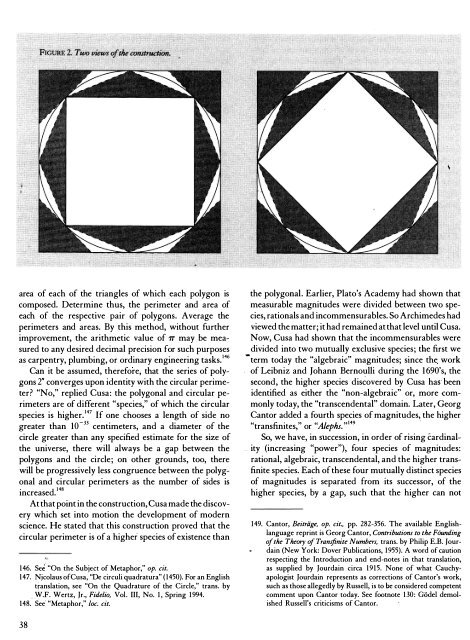PDF version of this article - Schiller Institute
PDF version of this article - Schiller Institute
PDF version of this article - Schiller Institute
You also want an ePaper? Increase the reach of your titles
YUMPU automatically turns print PDFs into web optimized ePapers that Google loves.
area <strong>of</strong> each <strong>of</strong> the triangles <strong>of</strong> which each polygon is<br />
composed. Determine thus, the perimeter and area <strong>of</strong><br />
each <strong>of</strong> the respective pair <strong>of</strong> polygons. Average the<br />
perimeters and areas. By <strong>this</strong> method, without further<br />
improvement, the arithmetic value <strong>of</strong> 1'( may be measured<br />
to any desired decimal precision for such purposes<br />
as carpentry, plumbing, or ordinary engineering tasks.146<br />
Can it be assumed, therefore, that the series <strong>of</strong> polygons<br />
2n converges upon identity with the circular perimeter?<br />
"No," replied Cusa: the polygonal and circular perimeters<br />
are <strong>of</strong> different "species," <strong>of</strong> which the circular<br />
species is higher.147 If one chooses a length <strong>of</strong> side no<br />
greater than 10-33 centimeters, and a diameter <strong>of</strong> the<br />
circle greater than any specified estimate for the size <strong>of</strong><br />
the universe, there will always be a gap between the<br />
polygons and the circle; on other grounds, too, there<br />
will be progressively less congruence between the polygonal<br />
and circular perimeters as the number <strong>of</strong> sides is<br />
increased.148<br />
At that point in the construction, Cusa made the discovery<br />
which set into motion the development <strong>of</strong> modern<br />
science. He stated that <strong>this</strong> construction proved that the<br />
circular perimeter is <strong>of</strong> a higher species <strong>of</strong> existence than<br />
146. See "On the Subject <strong>of</strong> Metaphor," op. cit.<br />
147. Nicolaus <strong>of</strong>Cusa, "De circuli quadratura" (1450). For an English<br />
translation, see "On the Quadrature <strong>of</strong> the Circle," trans. by<br />
_ W.F. Wertz, Jr., Fidelio, Vol. III, No. 1, Spring 1994.<br />
148. See "Metaphor," loco cit.<br />
38<br />
the polygonal. Earlier, Plato's Academy had shown that<br />
measurable magnitudes were divided between two species,<br />
rationals and incommensurables. So Archimedes had<br />
viewed the matter; it had remained at that level until Cusa.<br />
Now, Cusa had shown that the incommensurables were<br />
divided into two mutually exclusive species; the first we<br />
-term today the "algebraic" magnitudes; since the work<br />
<strong>of</strong> Leibniz and Johann Bernoulli during the 1690's, the<br />
second, the higher species disovered by Cusa has' been<br />
identified as either the "non-algebraic" or, more commonly<br />
today, the "transcendental" domain. Later, Georg<br />
Cantor added a fourth species <strong>of</strong> magnitudes, the higher<br />
" trans fimtes, ' " or "At ep h s. ,,149<br />
So, we have, in succession, in order <strong>of</strong> rising cardinality<br />
(increasing "power"), four species <strong>of</strong> magnitudes:<br />
rational, algebraic, transcendental, and the higher transfinite<br />
species. Each <strong>of</strong> these four mutually distinct species<br />
<strong>of</strong> magnitudes is separated from its successor, <strong>of</strong> the<br />
higher species, by a gap, such that the higher can not<br />
149. Cantor, Beitriige, op. cit., pp. 282-356. The available Englishlanguage<br />
reprint is Georg Cantor, Contributiom to the Founding<br />
<strong>of</strong> the Theory <strong>of</strong> Transfinite Numbers, trans. by Philip E.B. Jourdain<br />
(New York: Dover Publications, 1955). A word <strong>of</strong> caution<br />
respecting the Introduction and end-notes in that translation,<br />
as supplied by Jourdain circa 1915. None <strong>of</strong> what Cauchyapologist<br />
Jourdain represents as corrections <strong>of</strong> Cantor's work,<br />
such as those allegedly by Russell, is to be considered competent<br />
comment upon Cantor today. See footnote 130: Good demolished<br />
Russell's criticisms <strong>of</strong> Cantor.<br />
.



